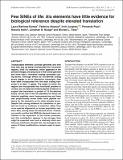| dc.contributor.author | Martinez-Gomez, Laura | |
| dc.contributor.author | Abascal, Federico | |
| dc.contributor.author | Jungreis, Irwin | |
| dc.contributor.author | Pozo, Fernando | |
| dc.contributor.author | Kellis, Manolis | |
| dc.contributor.author | Mudge, Jonathan M | |
| dc.contributor.author | Tress, Michael L | |
| dc.date.accessioned | 2021-01-12T23:09:56Z | |
| dc.date.available | 2021-01-12T23:09:56Z | |
| dc.date.issued | 2019-12 | |
| dc.date.submitted | 2019-10 | |
| dc.identifier.issn | 2631-9268 | |
| dc.identifier.uri | https://hdl.handle.net/1721.1/129396 | |
| dc.description.abstract | Transposable elements colonize genomes and with time may end up being incorporated into functional regions. SINE Alu elements, which appeared in the primate lineage, are ubiquitous in the human genome and more than a thousand overlap annotated coding exons. Although almost all Alu-derived coding exons appear to be in alternative transcripts, they have been incorporated into the main coding transcript in at least 11 genes. The extent to which Alu regions are incorporated into functional proteins is unclear, but we detected reliable peptide evidence to support the translation to protein of 33 Alu-derived exons. All but one of the Alu elements for which we detected peptides were frame-preserving and there was proportionally seven times more peptide evidence for Alu elements as for other primate exons. Despite this strong evidence for translation to protein we found no evidence of selection, either from cross species alignments or human population variation data, among these Alu-derived exons. Overall, our results confirm that SINE Alu elements have contributed to the expansion of the human proteome, and this contribution appears to be stronger than might be expected over such a relatively short evolutionary timeframe. Despite this, the biological relevance of these modifications remains open to question. | en_US |
| dc.description.sponsorship | National Human Genome Research Institute (Grants 2-U41-HG007234 and R01-HG004037) | en_US |
| dc.language.iso | en | |
| dc.publisher | Oxford University Press (OUP) | en_US |
| dc.relation.isversionof | http://dx.doi.org/10.1093/nargab/lqz023 | en_US |
| dc.rights | Creative Commons Attribution NonCommercial License 4.0 | en_US |
| dc.rights.uri | https://creativecommons.org/licenses/by-nc/4.0/ | en_US |
| dc.source | Oxford University Press | en_US |
| dc.title | Few SINEs of life: Alu elements have little evidence for biological relevance despite elevated translation | en_US |
| dc.type | Article | en_US |
| dc.identifier.citation | Martinez-Gomez, Laura et al. "Few SINEs of life: Alu elements have little evidence for biological relevance despite elevated translation." NAR Genomics and Bioinformatics 2, 1 (December 2019): lqz023 © 2019 The Author(s) | en_US |
| dc.contributor.department | Massachusetts Institute of Technology. Computer Science and Artificial Intelligence Laboratory | en_US |
| dc.relation.journal | NAR Genomics and Bioinformatics | en_US |
| dc.eprint.version | Final published version | en_US |
| dc.type.uri | http://purl.org/eprint/type/JournalArticle | en_US |
| eprint.status | http://purl.org/eprint/status/PeerReviewed | en_US |
| dc.date.updated | 2021-01-05T19:12:57Z | |
| dspace.orderedauthors | Martinez-Gomez, L; Abascal, F; Jungreis, I; Pozo, F; Kellis, M; Mudge, JM; Tress, ML | en_US |
| dspace.date.submission | 2021-01-05T19:13:03Z | |
| mit.journal.volume | 2 | en_US |
| mit.journal.issue | 1 | en_US |
| mit.license | PUBLISHER_CC | |
| mit.metadata.status | Complete | |
